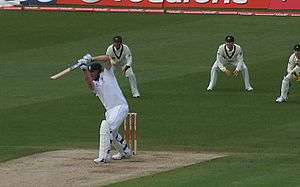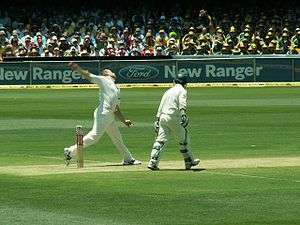All-rounder
An all-rounder is a cricketer who regularly performs well at both batting and bowling. Although all bowlers must bat and quite a few batsmen do bowl occasionally, most players are skilled in only one of the two disciplines and are considered specialists. Some wicket-keepers have the skills of a specialist batsman and have been referred to as all-rounders, but the term wicketkeeper-batsman is more commonly applied to them, even if they are substitute wicketkeepers who also bowl.
Definition
There is no precise qualification for a player to be considered an all-rounder and use of the term tends to be subjective. The generally accepted criterion is that a "genuine all-rounder" is someone whose batting or bowling skills, considered alone, would be good enough to win him/her a place in the team. Another definition of a "genuine all-rounder" is a player who can through both batting and bowling (though not necessarily both in the same match), consistently "win matches for the team" (i.e., propel his/her team to victory by an outstanding individual performance). By either definition, a genuine all-rounder is quite rare and extremely valuable to a team, effectively operating as two players.
Confusion sometimes arises when a specialist bowler performs well with the bat. For example, West Indies pace bowler Malcolm Marshall achieved ten scores of 50 or above in 107 Test innings between 1978 and 1991, but had a batting average of less than 19. He would be termed a "useful lower-order batsman", or indeed "a bowler who bats a bit". Equally, a specialist batsman/woman may be termed a "useful change bowler" and a good example of this is Australian Allan Border, who in a Test match against the West Indies in Sydney in January 1989 took 11 wickets for 96 runs (7/46 in the first innings and 4/50 in the second) as the conditions suited his occasionally used left-arm spin.[1]
One of the main constraints to becoming a recognised all-rounder is that batsmen/women and bowlers "peak" at different ages. Batsmen/women tend to reach their peak in their late twenties after their technique has matured through experience. Conversely, fast bowlers often peak in their early to mid twenties at the height of their physical prowess. Other bowlers, mostly spinners but also fast bowlers who can "swing" the ball, are most effective in their later careers.
In 2013, Ali Bacher used statistical analysis to argue that there had only been 42 genuine all-rounders in the history of Test cricket. He rated Garry Sobers as the best, followed by Jacques Kallis.[2]
Categorisation by use of statistics
One commonly used statistical rule of thumb is that a player's batting average (the higher the better) should be greater than his/her bowling average (the lower the better). In Test cricket, only two players i.e., Garfield Sobers and Jacques Kallis, have batting averages that are 20 greater than their bowling averages over their entire careers.[3] However, some other players have achieved such a differential over significant parts of their careers, such as Imran Khan. Wally Hammond and Doug Walters managed differences of 20.7 and 19.2, respectively, between their batting and bowling averages, however, they were generally regarded as occasional bowlers who could break partnerships rather than genuine all-rounders.
In overall first-class cricket, there are several players with significantly higher batting averages. Statistically, few can challenge Frank Woolley who had a batting average of 40.77 and a bowling average of 19.87. Woolley took over 2000 wickets in his career, scored more runs than anyone except Jack Hobbs and is the only non-wicketkeeper to have taken more than 1000 catches.[4]
Many all-rounders are better at bowling than batting or vice versa. Very few are equally good at both and hardly any have been outstanding at both. Thus the terms "bowling all-rounder" and "batting all-rounder" have come into use.[5] For example, Richard Hadlee had an excellent bowling average of 22.29 in Tests and a passable (yet unspectacular) batting average of 27.16, leading him to be termed a "bowling all-rounder". Meanwhile, a player like Jacques Kallis (batting average of 55.37 and bowling average of 32.65 in Tests) is known as a "batting all-rounder".[6]
Also, batting all-rounders may not bowl much due to injury concerns (e.g. Corey Anderson, Angelo Mathews), or their batting skills are far better than their bowling to begin with (e.g. Kane Williamson, Steve Smith) to the point they revert to being known as a batsman.[7]
Notable all-round feats
- V. E. Walker of Middlesex, playing for All-England versus Surrey at The Oval on 21, 22 & 23 July 1859, took all ten wickets in the Surrey first innings and followed this by scoring 108 in the England second innings, having been the not out batsman in the first (20*). He took a further four wickets in Surrey's second innings. All-England won by 392 runs.[8]
- On 15 August 1862, E. M. Grace carried his bat through the entire MCC innings, scoring 192 not out of a total of 344. Then, bowling underarm, he took all 10 wickets in the Kent first innings for 69 runs. However, this is not an official record as it was a 12-a-side game (though one of the Kent batsmen was injured).
- The first player to perform the double of 1000 runs and 100 wickets in an English season was W. G. Grace in 1873. He scored 2139 runs at 71.30 and took 106 wickets at 12.94. Grace completed eight doubles to 1886 and it was not until 1882 that another player (C. T. Studd) accomplished the feat.[9]
- In the 1906 English cricket season, George Herbert Hirst achieved the unique feat of scoring over 2000 runs and taking over 200 wickets. He scored 2385 runs including six centuries at 45.86 with a highest score of 169.[10] He took 208 wickets at 16.50 with a best analysis of 7/18.[11] In the same season, Hirst achieved another unique feat when he scored a century in both innings and took five wickets in both innings of the same match. Playing for Yorkshire versus Somerset at Bath, Hirst scored 111 and 117 not out, and took 6/70 and 5/45.[12][13]
- George Giffen (1886, 1893 and 1896) and Warwick Armstrong (1905, 1909 and 1921) achieved the double in an English season three times, the most by members of touring teams.[14]
- Alan Davidson was the first player to take ten wickets and score one hundred runs in a Test match. Playing for Australia against West Indies at Brisbane in 1960–61, he took 5/135 and 6/87, and scored 44 and 80 in what became the first Tied Test. He was playing throughout with a broken finger.[15]
- Twenty-three players, on a total of 32 occasions, have taken five wickets in an innings and scored a century in the same Test match. Ian Botham achieved this feat five times, while Jacques Kallis, Garfield Sobers, Mushtaq Mohammed, Shakib Al Hasan and Ravichandran Ashwin have all done so twice.[16]
- Ian Botham, Imran Khan and Shakib Al Hasan are only three players who have achieved the feat of scoring a century and take 10 wickets in a Test match.[17]
- In 2013, Bangladesh's Sohag Gazi became the first, and so far only, player to score a century and take hat-trick in same Test match.[18][19]
- Kapil Dev is the only player to score 5000 runs and take 400 wickets in Test cricket. He is also the youngest player to score 1000 runs and reach the 100, 200 and 300 wicket mark in Test cricket.[20][21][22][23]
- Viv Richards, Paul Collingwood and Rohan Mustafa are the only players to have taken a 5-wicket haul and scored a hundred in the same One-Day International. Fourteen more players have taken a 5-wicket haul and scored a half century in the same game. Shahid Afridi is the only player to achieve this feat thrice in his career and Yuvraj Singh & Shakib Al Hasan the only cricketers to do so in a World Cup match.[24]
- Jacques Kallis, Shahid Afridi and Shakib Al Hasan are only three all-rounders in the history of international cricket to reach 10,000 runs and take 500 wickets across all three formats.[25]
- In 2015, Shakib Al Hasan of Bangladesh became the first, and so far only, cricketer in history to be ranked the No.1 all-rounder by ICC in its Player Rankings in all three formats of the game (Test, ODI and Twenty20).[26]
See also
- Batsman
- Bowler (cricket)
- Double (cricket)
- Fielder
- Wicket-keeper
- Cricket terminology
References
- http://www.cricinfo.com/ci/engine/match/63499.html
- Celebrating South Africa's two-in-ones, Firdose Moonda, ESPNcricinfo, 10 September 2013
- "All-round records | Test matches | Cricinfo Statsguru | ESPNcricinfo.com". Cricinfo. Retrieved 9 December 2019.
- CricInfo – career batting recordsCricInfo – career bowling recordsCricInfo – career fielding records
- "Maynard hopes for new all-rounder". 16 July 2010. Retrieved 12 April 2019.
- http://www.dnaindia.com/sport/1875797/report-imran-khan-greatest-all-rounder-of-my-era-sir-richard-hadlee
- "The problem with England's fondness for allrounders". Cricinfo. Retrieved 27 December 2016.
- England v Surrey at Kennington Oval, 21–23 Jul 1859, cricinfo.com, retrieved 23 July 2016
- Webber, p.180.
- CricketArchive
- CricketArchive
- Webber, p.184.
- CricketArchive – match scorecard. Retrieved 26 November 2008.
- Webber, p.180-181.
- "1st Test Australia v West Indies Scorecard". Cricinfo.com.
- "Records / Test matches / All-round records / A hundred and five wickets in an innings".
- "century and 10 wicket in a test", HowStat.com
- "Bangladesh's Sohag Gazi first player to score a century and take hat-trick in same match against New Zealand", The Telegraph, 13 October 2013
- "Hat-trick and 50 in a test", Howstat.com
- "5 Test cricketers who have achieved rare feat of 3000 runs & 400 wickets". Sportskeeda.
- "Profile". Cricinfo.
- "Kapil Dev's International career in numbers". Crictracker.
- "Profile". Cricbuzz.
- "Records / One Day Internationals / All-round records / A Fifty and five wickets in an innings".
- Kumar, Ram (7 June 2018). "Stats: Shakib Al Hasan fastest to register 10,000 runs and 500 wickets in international cricket history". sportskeeda. Retrieved 16 June 2018.
- "Shakib number one all-rounder in all formats". Prothomalo.com.
Bibliography
- Benaud, Richie (2005). My Spin on Cricket. Hodder and Stoughton. ISBN 0-340-83393-9.
- Trueman, Fred (2004). As It Was. Macmillan. ISBN 0-330-42705-9.
- Webber, Roy (1951). The Playfair Book of Cricket Records. Playfair Books.

